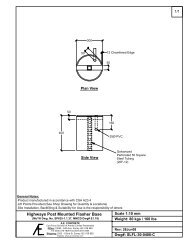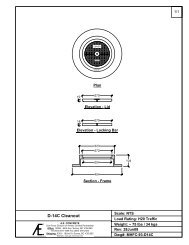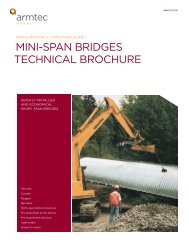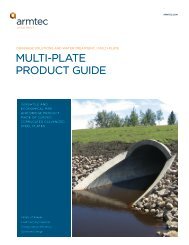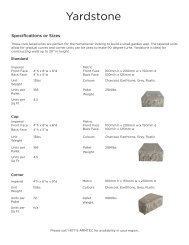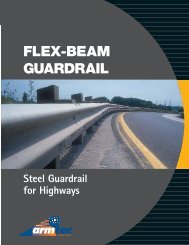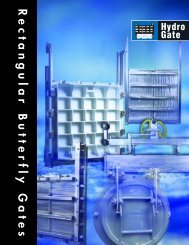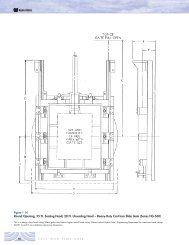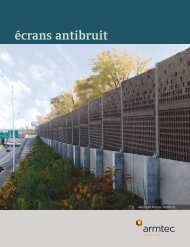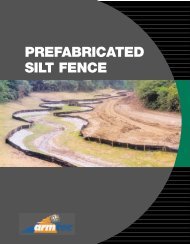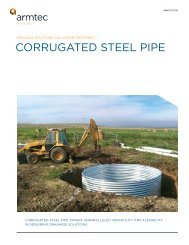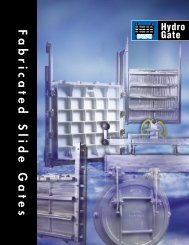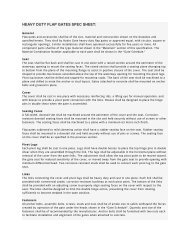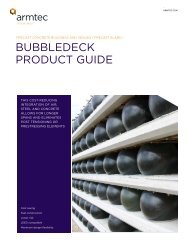Hel Cor Product Brochure - Armtec
Hel Cor Product Brochure - Armtec
Hel Cor Product Brochure - Armtec
Create successful ePaper yourself
Turn your PDF publications into a flip-book with our unique Google optimized e-Paper software.
Drainage Solutions in Steel<strong>Hel</strong>-<strong>Cor</strong> Lock-Seam <strong>Cor</strong>rugated Steel Pipe<strong>Armtec</strong> first introduced <strong>Hel</strong>-<strong>Cor</strong> pipeto the construction industry in 1970.Since then, <strong>Hel</strong>-<strong>Cor</strong> has proven itseffectiveness and durability incountless installations, under diverseconditions.The inherent strength of thesehelically-corrugated, light-weightsteel sections, in conjunction withthe diversity of sizes, couplings,fittings, and finishes, combine tomake <strong>Hel</strong>-<strong>Cor</strong> one of the mostversatile, cost-effective systems forapplications such as:• Culverts• Sewers• Stream Enclosures• Underpasses• Intakes• Outfalls• Water transmission linesThe annular corrugated pipe ends,when fitted with Hugger bandsand O-ring gaskets, provideconduits with very low rates ofinfiltration and exfiltration.<strong>Hel</strong>-<strong>Cor</strong> is available in diametersranging from 150 to 3600 mm, intwo shapes (full-round and pipearch);two corrugations; five wallthicknesses; and three factoryappliedfinishes. The material andfabrication of <strong>Hel</strong>-<strong>Cor</strong> Lock SeamPipe conforms to CSA StandardCAN/CSA G401.Flexibility and HighCompressive StrengthThe helical corrugations andcontinuous lock-seam providehigh ring compression strengthin a relatively light-weight,thin-walled structure.Vertical live and dead-loads aretransferred to the surrounding soil,thus creating a composite steel/soilinteraction, effectively distributingthe load around the entire circumference.Unit pressure on the top andbottom of the pipe can be as little asone third of that encountered with Flexible Ring Compressionrigid pipe under identical conditions.Economy of InstallationDepending upon the installation, costsavings in excess of 25% over othersystems are not uncommon.The long, light-weight sections of<strong>Hel</strong>-<strong>Cor</strong> pipe lend themselves to fast,easy handling and installation withlight equipment and simple tools.Shapes: The full-round pipe is usedfor most typical, general-purposeapplications.Pipe-arch is used where headroom islimited. The low, wide pipe-arch shape Rigid Ring Compressionprovides the required hydrauliccapacity at lower depths of flow. Forfast, unrestricted run-off at low waterlevels, the pipe-arch is very effective.Selection guides for full round andpipe-arch are shown in Tables 6 to 14.<strong>Cor</strong>rugations: <strong>Hel</strong>-<strong>Cor</strong> lock-seampipe is supplied in three corrugations:38 x 6.5 mm, 68 x 13 mm, and 125 x26 mm. The latter provides additionalstiffness, which is especially importantwith larger pipes to minimizedeflection during backfilling. Refer topages 6 and 7 for the section propertiesof the three corrugations.Table 1 - <strong>Cor</strong>rugation Profiles (mm) & DiametersNominalPitch Depth Inside Diameter (mm)38 6.5 150, 200, 25068 13 300 - 2000125 26 1200 - 36002
Durability Considerations –Three FinishesTo accommodate a variety ofdurability and hydraulic designconsiderations, three factory-appliedfinishes are available. These areGalvanized Steel, Aluminized SteelType 2 and Polymer Coated Steel.Galvanized Steel: This standardgeneral-purpose finish is acontinuous galvanized coatingapplied using stringent qualitycontrol procedures to ensureexcellent bonding of the coating tothe steel. These installations haveproven their durability in many yearsof field application.Generally, most culvert and stormsewer sites in Canada experiencerelatively neutral conditions. Theheavy zinc coating of the standardgalvanized finish provides sufficientprotection in most installations.Aluminized Steel Type 2: For morecorrosive environments, <strong>Armtec</strong>recommends the use of AluminizedSteel Type 2. The aluminum coatinghas superior corrosion resistancethan zinc galvanizing and displaysbetter abrasion resistance. Mostagencies use a service life estimatethat is significantly greater than thatof plain galvanized steel.Polymer Coated CSP: Inparticularly aggressive environmentsconsideration should be given to theuse of polymer coated corrugatedsteel pipe. Polymer coated CSPutilizes galvanized steel protected bya mechanically and chemicallylaminated polymer film on bothsides of the steel sheet. Thisproduct combines the strength ofsteel with the durability of highdensity polymer.Annular <strong>Cor</strong>rugated Ends:Couplers and Fittings<strong>Hel</strong>-<strong>Cor</strong> pipe features universalannular corrugated ends, so a varietyof couplings may be used for thepipe and pipe-arch.Three types of couplers arerecommended:• Hugger Band• Annular corrugated standard boltand angle coupler• Dimpled coupling bandHugger Band: <strong>Armtec</strong> offers ahighly effective Hugger Band joint.These 500 mm wide bands arerecommended for storm sewers andother installations where low leakagerates and resistance to longitudinaldisjointing are prime requirements.When used with O-ring gaskets, theHugger Band provides an extremelytight joint with low infiltration andexfiltration rates.3
Standard Annular <strong>Cor</strong>rugatedCoupler: The standard annularcorrugated coupler, fitted with boltand angle attachments, seatssnugly onto the pipe-endcorrugations, and is suitable formost general-purpose applications.Dimpled Coupling Band: Thiscoupler is used where helical and/orannular corrugated pipe ends are tobe coupled. Dimpled couplers areavailable with steel angles or withwedge connectors as shown.Angle Type: 300 to 1800 mmWedge Type: 300 to 1200 mmFittingsStandard fittings such as: tees,wyes, elbows, saddle branches,and reducers are available for theround pipe and pipe-arch.Special fittings, such as manholesand catchbasins can becustom-fabricated to suit individualrequirements.Typical Fittings4
End-Treatments<strong>Armtec</strong> supplies durable, lightweightend-sections for improved hydraulicefficiency and erosion control. Thesesections help reduce scour at inletsand undermining at outlets, whileproviding an attractive, economicalmeans of blending the culvert endswith the sloping embankment.There are a variety of end finishesavailable for corrugated steel pipe.These options include skewed andbevelled ends, steel and polymer endsections and a variety of headwallsand cut off walls.5
<strong>Hel</strong>-<strong>Cor</strong> Pipe andPipe-Arch68 mm x 13 mm<strong>Cor</strong>rugationsTable 2 – Section PropertiesCoated Design Area of Moment of Section Radius of Tangent Tangent DevelopedThickness Thickness Section Inertia Modulus Gyration Length Angle Width(mm) (mm) (mm 2 /mm) (mm 4 /mm) (mm 3 /mm) (mm) (mm) (f o degrees) Factor*1.6 1.40 1.512 28.367 4.024 4.332 19.578 26.734 1.0802.0 1.82 1.966 37.108 5.111 4.345 19.304 26.867 1.0802.8 2.64 2.852 54.565 7.114 4.374 18.765 27.136 1.0803.5 3.35 3.621 70.159 8.743 4.402 18.269 27.381 1.0814.2 4.08 4.411 86.706 10.334 4.433 17.755 27.643 1.081* Developed width factor measures the increase in profile length due to corrugating.Table 3 – Handling Weight and End AreaPipe End Handling Weight - Galvanized (kg/m)Diameter Area Wall Thickness (mm)(mm) (m 2 ) 1.3 1.6 2.0 2.8 3.5 4.2150* 0.018 5.9 7.2200* 0.031 7.7 9.5250* 0.049 9.6 12300 0.071 14 18400 0.126 19 24500 0.196 24 30600 0.283 28 35 49700 0.385 33 41 57800 0.503 37 47 65900 0.636 42 53 73 901000 0.785 58 81 1001200 1.131 70 97 1201400 1.539 113 140 1681600 2.011 130 160 1921800 2.545 179 2152000 3.142 239*38 x 6.4 corrugation profile6
<strong>Hel</strong>-<strong>Cor</strong> Pipe125 mm x 25 mm<strong>Cor</strong>rugationsTRadius = 40 mmPitch = 125 mmDepth = 25 mmTL0Table 4 – Section PropertiesCoated Design Area of Moment of Section Radius of Tangent Tangent DevelopedThickness Thickness Section Inertia Modulus Gyration Length Angle Width(mm) (mm) (mm 2 /mm) (mm 4 /mm) (mm 3 /mm) (mm) (mm) (f o degrees) Factor*1.6 1.40 1.549 133.300 9.730 9.277 18.568 35.564 1.1062.0 1.82 2.014 173.720 12.489 9.287 17.970 35.811 1.1072.8 2.64 2.923 253.237 17.684 9.308 16.742 36.330 1.1073.5 3.35 3.711 322.743 21.993 9.326 15.600 36.826 1.108* Developed width factor measures the increase in profile length due to corrugating.Table 5 – Handling Weight and End AreaPipe End Handling Weight - Galvanized (kg/m)Diameter Area Wall Thickness (mm)(mm) (m 2 ) 1.6 2.0 2.8 3.51200 1.131 57 71 100 1241400 1.539 83 116 1441600 2.011 95 132 1651800 2.545 106 148 1852000 3.142 118 165 2052200 3.801 129 181 2252400 4.524 141 197 2452700 5.726 159 222 2763000 7.069 246 3063300 8.553 270 3363600 10.179 3677
<strong>Hel</strong>-<strong>Cor</strong> Pipe Height of Cover LimitsCL-625 (CAN CSA-S6-06) and AREMA Cooper E-80 LoadingsTable 6 – 68 mm x 13 mm <strong>Cor</strong>rugationsMaximum Cover in MetresSpecified Thickness in MillimetresDiameterMinimum Cover(mm) CL-625 E-80 1.60 (mm) 2.00 (mm) 2.80 (mm) 3.50 (mm) 4.20 (mm)300 300 300 70 91400 300 300 53 68500 300 300 42 54600 300 300 35 45 66700 300 300 30 39 57800 300 300 26 34 50900 300 300 23 30 44 56 701000 300 300 21 27 40 50 631200 300 300 23 33 42 521400 300 500 27 35 431600 300 500 22 28 351800 500 500 22 272000 500 500 22Table 7 – 125 mm x 25 mm <strong>Cor</strong>rugationsMaximum Cover in MetresSpecified Thickness in MillimetresDiameterMinimum Cover(mm) CL-625 E-80 1.60 (mm) 2.00 (mm) 2.80 (mm) 3.50 (mm)1200 300 500 18 23 341400 300 500 15 20 29 351600 300 500 13 18 25 311800 300 500 12 16 22 282000 300 500 11 14 20 252200 300 700 10 12 18 232400 500 700 11 17 212700 500 700 15 183000 500 1000 13 163300 500 1000 143600* 700 1000 12** Flexibility limit exceeded – for specified use only.1. Dead load is based on a unit weight of backfill of 19kN/m 3 .2. Where Height of Cover exceeds the Diameter, a reduction load factor of 0.86 has been used.3. Live Load includes impact.4. Minimum cover is taken from top of pipe to profile grade or to the top of the finished granular base.5. Special care must be taken with truck loads during construction.6. Foundation investigation is recommended practice.7. The above Height of Cover tables are industry standards, Local, Provincial or Federal standards may differ.8
<strong>Hel</strong>-<strong>Cor</strong> Pipe-Arch DetailsTable 8 – 68 mm x 13 mm <strong>Cor</strong>rugationsDiameter of Span Rise B WaterwayPipe of Equal (mm) (mm) (mm) AreaPeriphery(Square(mm)Metres)400 450 340 130 .11500 560 420 165 .19600 680 500 190 .27700 800 580 220 .37800 910 660 255 .48900 1030 740 265 .611000 1150 820 310 .741200 1390 970 375 1.061400 1630 1120 430 1.441600 1880 1260 500 1.871800 2130 1400 560 2.36125 mm x 25 mm <strong>Cor</strong>rugations (where available)Diameter of Span Rise B WaterwayPipe of Equal (mm) (mm) (mm) AreaPeriphery(Square(mm)Metres)1600 1780 1360 635 1.931800 2010 1530 650 2.442000 2230 1700 660 2.972200 2500 1830 750 3.442400 2800 1950 805 4.272700 3300 2080 905 5.393000 3650 2280 1005 6.603300 3890 2690 1090 8.293600 4370 2890 1195 9.76Note: The pipe-arch is available with the 125 x 25 corrugation.For weights of pipe-arches with the 68 x 13 corrugation refer to theweight of the circular pipe with the equivalent periphery.Table 9 – Height-of-Cover Limits for<strong>Cor</strong>rugated Steel Pipe-Arch CL-625 Live LoadMaximum Height of Fill (m)Span x Rise Minimum for the Following(mm) Thickness <strong>Cor</strong>ner BearingRequired (mm)Pressures200 kPa 300 kPa 400kPa450 340 1.6 6.0 8.9 11.9560 420 1.6 5.9 8.9 11.8680 500 1.6 5.9 8.8 11.7800 580 1.6 5.8 8.7 11.7910 660 1.6 5.8 8.7 11.61030 740 1.6 5.7 8.6 11.51150 820 2.0 5.7 8.5 11.31390 970 2.8 5.6 8.4 11.21630 1120 3.5 5.5 8.2 11.01880 1260 3.5 5.4 8.1 10.82130 1400 3.5 5.3 8.0 10.6Min. cover from top of pipe-arch to subgrade = 300 mm<strong>Cor</strong>ner bearing pressures govern, in all cases.9
Perforated <strong>Hel</strong>-<strong>Cor</strong> ® PipeFor Ground Water ControlFirst introduced by <strong>Armtec</strong> in 1925,perforated corrugated steel pipeprovides a lasting system to drainground water under paved surfacessuch as roadways, parking lots,airport runways, recreational areas aswell as areas adjacent to buildings,bridge abutments and retainingwalls. It offers exceptional performancefor ground water drainage inlow lying areas like parklands, farmsand agricultural areas.Perforated <strong>Hel</strong>-<strong>Cor</strong> is widely acceptedas a practical, durable, economicalmeans of controlling unwantedground water. This solution is efficientand costs less than repeatedsurface repairs and virtually eliminatesmaintenance concerns.Perforated pipe is available in plaingalvanized for most applications. Inparticularly aggressive environments,it is strongly recommended that considerationbe given to using eitherAluminized Steel Type II.Pipe Size SelectionFor normal subdrainage, theinfiltration of ground water is veryslow. Therefore, approximately 150metres of 150 mm diameter pipemay be used as an interceptor beforeany increase in pipe diameter isrequired. Where extremely perviousmaterial is being drained or wheresprings are encountered, larger sizesmay be required.Placing of Perforations<strong>Armtec</strong> recommends that the pipe beplaced with the perforations down.This hinders solids from entering thepipe and keeps the water table lower.Recommended BackfillThe trench should be excavated withapproximately 100 mm of clearanceat the sides of the pipe so thatpervious backfill can surround thepipe. For the filter backfill, concretesand or other commonly availablecoarse sand-gravel mixtures performsatisfactorily for perforated pipe inmost soils.GeotextileGeotextile is widely used inperforated pipe applications,particularly where graded filtermaterial is not available. <strong>Armtec</strong> canprovide a low-cost knitted polyestersock to encase the pipe. More criticalinstallations call for a high qualitynon-woven geotextile such as<strong>Armtec</strong> 140 to separate the trenchfillfrom the native material.Pipe OutletsPerforated pipe’s cantilever strengthmakes it ideal for use as a projectingpipe outlet.Free outlets are important, and thefailure of subdrains to properlyfunction can often be attributed toplugged, damaged or improperoutlets. Outlet pipes should beprotected from damage bymaintenance equipment. A suitablebarrier such as a hinged rodent trapshould be used to keep out wildlifewhose nests could cause clogging.Spacing of LateralsDraining large, comparatively flatareas usually requires a parallel orherringbone system of drainage pipe.table No. 10 may be used as a generalguide in laying out the system. Thespacing used on highways and railwaysis controlled by the location ofthe water-bearing strata.Standard Perforations*All perforations nominal 10 mm diameterTable 10 - Dimensions, Thicknesses and Spacing of Perforations*Nominal Minimal No. Minimum Width NormalInternal of Rows of Unperforated ThicknessDiameter Perforations Segment Specified150 mm 6 110 mm 1.3 mm200 mm 6 150 mm 1.3 mm250 mm 6 185 mm 1.6 mm300 mm 6 230 mm 1.6 mm400 mm 6 305 mm 1.6 mm* Random hole spacing around the circumference is available on request.10
<strong>Hel</strong>-<strong>Cor</strong> Installation: Bedding and BackfillingWell graded, drainable backfill isrecommended for good compaction.The designer should refer to thegradation and backfill specificationsof the appropriate provincial highwaystandard. Stumps, rocks, frozen lumpsand other debris should be removedfrom the bedding site.Round pipe can be built on a flatsand cushion with rodding and tampingof the backfill around thehaunches. Alternatively, the pipecan be installed on a pre-shapedgranular base.The pipe-arch bottom arc mustbe erected on a pre-shaped sandcushion. The support under thebottom arc should be relativelyyielding but under the cornerhaunches the supporting groundmust be highly stable. Specialattention should be given tocompacting the backfill around thecorner arcs where the highest soilpressures develop.Backfill should be spread in 150 mmlayers alternating from one side ofthe pipe to the other, and shouldextend above the pipe to a minimumheight of 300 mm or one sixth thespan, whichever is greater.Compaction using suitablemechanical equipment should becarried out to achieve the specifiedbackfill density.Care must be taken to ensure that thepipe or pipe-arch is not damaged byheavy equipment traffic during construction.11
Other uses for <strong>Hel</strong>-<strong>Cor</strong> <strong>Cor</strong>rugated Steel PipeWind FarmsPole CribsStormwater Detention Tanks Temporary Smoke Stacks Relines• Void Tubes• Hickenbottom Drains• Firewater Tanks• UtilidorsHead Office: 370 Speedvale Ave. W., P.O. Box 3000, Guelph, ON N1H 6P2www.armtec.comSales Offices: Nanaimo, Prince George, Langley, Edmonton, Calgary, Lethbridge,Saskatoon, Winnipeg, Thunder Bay, Sudbury, Guelph, Peterborough, Chesterville,Forest, Orangeville, Comber, Montreal, Quebec City, St. Clet, Sackville, Truro,Sleeman Park, Bishop’s Falls and St. John’s.DS/30C/BP/1108



